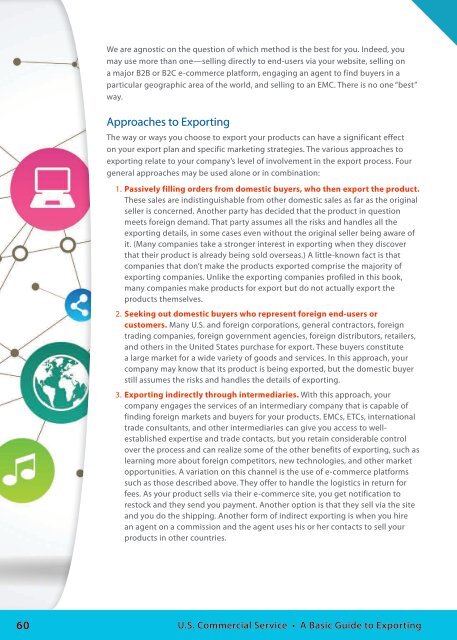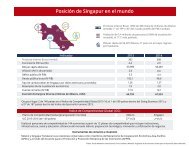basic-guide-to-exporting_Latest_eg_main_086196
basic-guide-to-exporting_Latest_eg_main_086196
basic-guide-to-exporting_Latest_eg_main_086196
Create successful ePaper yourself
Turn your PDF publications into a flip-book with our unique Google optimized e-Paper software.
We are agnostic on the question of which method is the best for you. Indeed, youmay use more than one—selling directly <strong>to</strong> end-users via your website, selling ona major B2B or B2C e-commerce platform, engaging an agent <strong>to</strong> find buyers in aparticular geographic area of the world, and selling <strong>to</strong> an EMC. There is no one “best”way.Approaches <strong>to</strong> ExportingThe way or ways you choose <strong>to</strong> export your products can have a significant effec<strong>to</strong>n your export plan and specific marketing strat<strong>eg</strong>ies. The various approaches <strong>to</strong><strong>exporting</strong> relate <strong>to</strong> your company’s level of involvement in the export process. Fourgeneral approaches may be used alone or in combination:1. Passively filling orders from domestic buyers, who then export the product.These sales are indistinguishable from other domestic sales as far as the originalseller is concerned. Another party has decided that the product in questionmeets foreign demand. That party assumes all the risks and handles all the<strong>exporting</strong> details, in some cases even without the original seller being aware ofit. (Many companies take a stronger interest in <strong>exporting</strong> when they discoverthat their product is already being sold overseas.) A little-known fact is thatcompanies that don’t make the products exported comprise the majority of<strong>exporting</strong> companies. Unlike the <strong>exporting</strong> companies profiled in this book,many companies make products for export but do not actually export theproducts themselves.2. Seeking out domestic buyers who represent foreign end-users orcus<strong>to</strong>mers. Many U.S. and foreign corporations, general contrac<strong>to</strong>rs, foreigntrading companies, foreign government agencies, foreign distribu<strong>to</strong>rs, retailers,and others in the United States purchase for export. These buyers constitutea large market for a wide variety of goods and services. In this approach, yourcompany may know that its product is being exported, but the domestic buyerstill assumes the risks and handles the details of <strong>exporting</strong>.3. Exporting indirectly through intermediaries. With this approach, yourcompany engages the services of an intermediary company that is capable offinding foreign markets and buyers for your products. EMCs, ETCs, internationaltrade consultants, and other intermediaries can give you access <strong>to</strong> wellestablishedexpertise and trade contacts, but you retain considerable controlover the process and can realize some of the other benefits of <strong>exporting</strong>, such aslearning more about foreign competi<strong>to</strong>rs, new technologies, and other marke<strong>to</strong>pportunities. A variation on this channel is the use of e-commerce platformssuch as those described above. They offer <strong>to</strong> handle the logistics in return forfees. As your product sells via their e-commerce site, you get notification <strong>to</strong>res<strong>to</strong>ck and they send you payment. Another option is that they sell via the siteand you do the shipping. Another form of indirect <strong>exporting</strong> is when you hirean agent on a commission and the agent uses his or her contacts <strong>to</strong> sell yourproducts in other countries.60U.S. Commercial Service • A Basic Guide <strong>to</strong> Exporting





